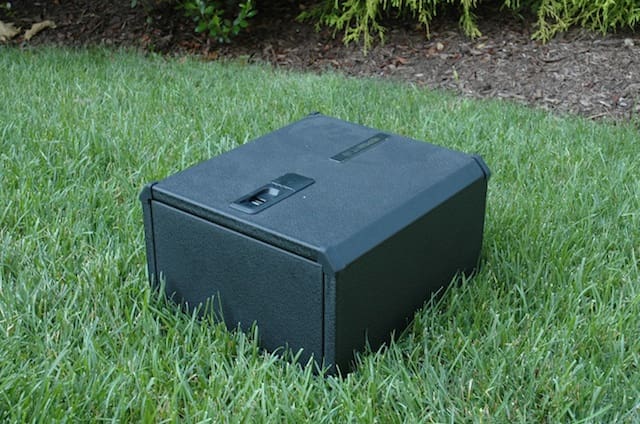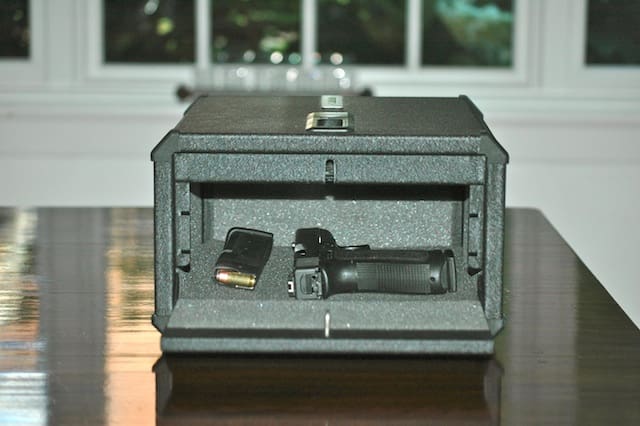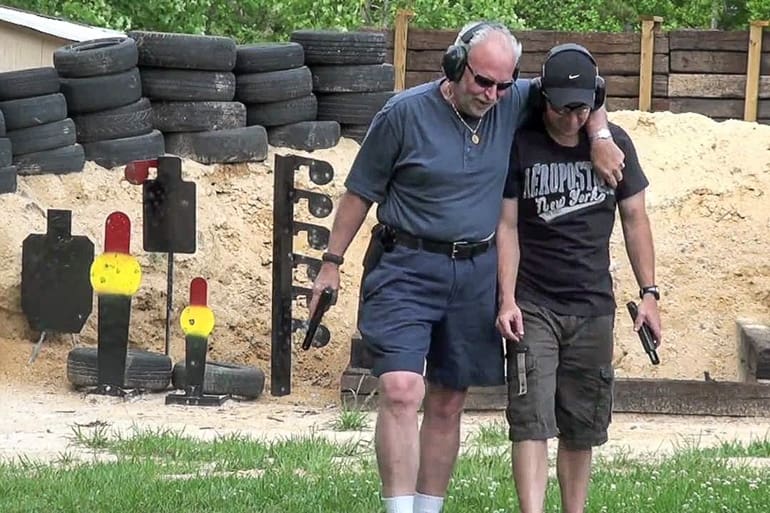“Baltimore police have identified the teenage victim of a fatal shooting which occurred after a sleepover in Cherry Hill Saturday morning,” baltimoresun.com reports. “Michael Brooks, 15, was shot and killed by an unidentified 11-year-old who was apparently playing with a gun, police said. Police could not say how many times Brooks was shot or who owned the gun. The gun was secured in the house, but the children had found a key or pass code to unlock it, said police spokesman Kevin Brown.” The $300 (or less from a dealer) 9G INPRINT BIOMETRIC SAFE is simple to set-up, holds a full size handgun and a spare mag, and opens reliably with a practiced swipe of any designated digit. No key. No code. Need I say more? Let’s start with this . . .
The 9G INPRINT BIOMETRIC SAFE is not a safe. Technically, tactically, it’s a security device. For one thing, 9G’s metal box is not fireproof. More importantly, if a burglar wants to remove your gun from an INPRINT safe, a common crowbar will help him or her liberate the weapon in a matter of seconds. And if the bad guys lack the brute force and experience needed to open the box in a New York Minute, they can simply carry it away. Or prise the 9G off its bolt holes and then carry it away. This is not the gun safe you’re looking for.
The INPRINT is, however, the ideal solution for balancing the need to keep your gun out of the hands of children with the [hopefully] potential need to gain fast access to your handgun when you hear the proverbial bump-in-the-night. (‘Cause you home carry all other times, right?) You simply hook-up a 9V battery, shove the battery back in the hole, press a button in the hole, swipe your finger across the scanner until the lights flash and Bob’s your uncle. Test it (there are keys for backup), place your gun and spare mag inside, close the door and you’re done.
The obvious concern: the INPRINT’s biometric recognition software will fail. In the biometric safe biz, there are two performance metrics: the “False Acceptance Rate” (FAR) and the “False Rejection Rate” (FRR). 9G’s main man Ken Stacey claims his not-a-safe-really will accept an unauthorized fingerprint once out of every 100,000 swipes. His competition (GunVault’s biometric box) uses last generation software, with a 1 out 5,000 FAR. The chances of unauthorized access are minuscule in both cases (so to speak)—especially when compared to the odds that a clever, gun-curious child will secure a code or key.
According to the 9G website, the INPRINT’s FRR (failure to recognize your finger) is “extremely low.” I tested the INPRINT BIOMETRIC SAFE 100 times with no recognition failures whatsoever. More to the point, I reckon it’s an invidious distinction. Setting aside the 9G’s ability to eliminate the possibility of the stolen code/key-related tragedy above, the real question is this: what are the relative chances you’ll screw-up a key or a code-based gun safe?
First, know this: like any other system, the INPRINT scanner requires practice. You put your finger on the reader, WAIT UNTIL TWO LIGHTS ILLUMINATE, then swipe. With battery power, that’s a two-second delay. With AC power, it’s down to half-a-second. As you can see from the video above, Sam screwed it up. After a bit of practice and patience, she can do it with her eyes closed. Second, note that key and keypad gun safes also have a FAR. I’ve failed to enter the correct code into my GunVault’s four button keypad twice-in-a-row—under no pressure whatsoever. If the SHTF, my keypad confidence is low.
In case you hadn’t figured it out, I’m sold on biometrics. And while the 12″ deep, 7″ high and 11″ wide INPRINT SAFE’s got a Bigfoot-sized footprint, that’s a good thing, not a bad thing. The 9G product offers more than enough lebensraum to grab my second generation Glock 21 from its foam bed without hesitation, deviation or repetition. And there’s enough “extra” space to stash a full-size magazine, useful for those occasions where 16 rounds of .45 caliber Wilson Combat hollow point ammunition just won’t git ‘er done. No light. No shelf. Just quick and easy access to my go-to gatt.
The INPRINT BIOMETRIC SAFE should be viewed as a nighttime addition to home carry, not an alternative. But anyway you look at it, 9G’s ballistic box is a no-brainer. Both in terms of its operation and whether or not you should buy one. You could even say the 9G ends any and all debate over the advisability of keeping a handgun by your bedside. Yes, you should. In this. Otherwise you risk terrible, avoidable consequences. In fact, if the 9G cost one G it would be worth every penny. Parents and grandparents, think of it this way: how much is your child’s life worth?






There’s only one really safe way to protect children from guns: ban all children. The Second Amendment covers guns. There’s no such amendment for kids. The SCOTUS says that we have a right to guns in our homes, but not kids. So get rid of them. The kids I mean. We have the right to the pursuit of happiness. How can anyone pursue happiness when their kid could grow up to be The New Magoo? So keep your guns on your person or in your safe and stow all children somewhere else. Anywhere else. Far away. But not here.
P.S.: That’s a nice security device. Why did you throw it out onto your lawn?
I have to agree. We have banned all persons under 18 from our house. If someone brings a minor into the house the child must be securely leashed at all times. The leash may be no longer than 6′ and the child must be under the direct control of the parent at all times.
Parents must clean up after their children as well. You may not leave your child’s mess for others to clean up. Convenient waste stations with plastic bags are available in all of the pocket parks.
Failure to obey any of the child regulations may result in the loss of all parenting privileges and fines.
wouldn’t the “false acceptance rate” be the rate at which the fingerprint of an unauthorized user gets “falsely accepted” and opens the box?
wouldn’t the figure of merit in a bump-in-the-night scenario be the false rejection rate? i.e. the rate at which the authorized user’s fingerprint is erroneously rejected.
I’m no biometrics expert, but I see no reason why a low FAR would necessarily result in a low FRR.
I think you got it right. The FAA is the chance that the unauthorized opens it when they should not, the FRR is the chance that you can’t open it when you need to.
Good point. The INPRINT website says “False rejection rate (FRR) is extremely low.” I’ll ask them to put some numbers to that tomorrow, and provide some perspective.
Over at GunVault, they say this about that: “A high-performance algorithm is used to achieve speedy identification of enrolled fingerprints; and at the same time has a very low False Reject Rate (FRR) for a given False Accept Rate (FAR). ”
Meanwhile, text amended.
OK, so you didn’t test if you could pop open the semi-secure storage device by “bouncing” it because it’s not really a safe. I understand and I agree. Now, what about false positives? Can an unauthorized finger open your semi-secure storage device?
I “bounce tested” the INPRINT. It didn’t open. If you’d like me to upload a video, I’d be glad to.
I also tested it with non-authorized fingers: children, MIL, etc. Nada.
Good concept but still needs work. The wait then swipe process is not ideal.
The company I work at implemented biometric attendance tracking system where you just place your finder on the scanner and it reads it in under half a second, no swiping required (and that fingerprint reader costs under $100, so the technology isn’t expensive). Granted, that reader it hooked up to a PC/laptop so there’s more processing power than in a stand alone, battery operated box, but at least they could take the swiping out of the equation.
Here’s another idea: how about a RFID card or whatever tech they use for those door locks where you don’t have to take your key card out of the wallet (similar to the latest model luxury cars with keyless ignition). Have a card or a key fob on you, just make a habit of leaving your keys/wallet next to the gun safe while you are home.
Or how about something like a time lock – get home, punch in a code and the safe unlocks till next morning when you leave for work.
Personally I have one of those older Sentry safes that requires a key and a combination to open. When I’m home, I have the key inserted and combination set.
To open, just turn the key and open the door. When leaving home, take the key out. Simple and effective.
Its a good box, In fact anything lost by the box not being an actual safe will soon be gained by the safe monitoring the company intends to implement and demonstrated at this years shot show. This product, they have already issued a press release for, will be the first web enabled safe in the world. It will report all of its interactions to a cloud. Exciting when coupling biometrics and monitoring in the same breath. Really cool!
I love the idea of biometrics finger scans for personal security. However, a few years ago finger print scanners started showing up on the laptops we order at work. We were tasked with testing the security of these scanners. Now this was about 2 years ago . I’m sure the technology has come along way since then. Here is what we found.
At that time it wasn’t that difficult to fool the reader. We did a little web research and found that we could fill a latex glove with warm water and swipe the finger of the glove on the scanner and 1 out of 10 times it would login to the PC. Alos, depending on the type of scanner there were other ways to fool it. Other methods researched but not test by us are: A ziploc of warm water, breathing a long warm breath on the scanner, and a few others I can’t remember….
(I wonder about the affect of cold hands on failure to recognize rate)
I have a new laptop with a scanner and since the issue is on my mind again, I plan to test it scanner in the next few days. I’m sure the scanners are MUCH better than they used to be but I thought this was worth mentioning.
I don’t think it would be a big issue for thieves, but if a kid with time on his hands wanted to get in that case it might be possible.
Here a link to some neat info on fooling the scanner.
http://www.combibo.net/articles/hacking_the_biometric_fingerprint_scanner/
I would love to see that bounce test video… This device does look sharp and seems to work unlike the others on the market that I have bought and used.
I like how this one has that active scanning piece instead of the hold your finger over a glass button tactic. Great product 9g and thank you Robert for posting this product review.
A couple of comments on the review. I am not personally an expert… however my engineer that created the circuit board explained to me that FAR is a modifiable setting related to the hardware. We at 9g are on our second generation of biometric devices so we were able to use the latest technology and move it up to the 1-100,000. The FRR is more of how the device works and I have no way of quantifying that except through the user experience. As Robert says he tried 100 times and it works every time.
As far as the time to open. I did not send Robert an AC adaptor. When the device is plugged in you don’t have to “wake it up” so you swipe immediately and within 2 seconds you are to your gun. Robert tested with battery where you have the 1/2 second wakeup time. This is to save the 9volt battery from expiring quickly.
Our goal at 9g was to create an easy to use security device. With a push button device you have to use fine motor skills and remember a number. With biometrics (that work) you only have to swipe your finger — a gross motor skill. A big difference when it counts is that ours is a SINGLE FINGER operation.
Finally a comment on the comparison with the biometrics on PC’s. What we have found is that the PC biometrics is affected greatly by what else is running on the PC at the time… or the age of the PC, etc. We have a processor within our device solely for the operation of the scanner… no other overhead so it works with great consistency.
If you have any questions please email [email protected] or comment here and I will do my best to respond.
Ken
Well this is the problem with all gun safes in a real life scenario its dark or there’s low light making the safe harder to open. Me unfortunately I’m single and have no kids so I leave my home defense weapon in/on my night stand next to the bed. My brother on the other hand has 3 kids not an option specially when the kids playing around in the house or their room or have a bad dream and runs into their room at night.
I’m about to make a decision between HDX 250, this one, and Ft Knox PB4 pistol,box with Simplex lock. I’ve read so much my head is bursting. People have complained about the buttons on the PB4 being very loose and sometimes not opening. other writers loved it. I’m in a quandary…PLEASE HELP! Will buy something within a day.
Comments are closed.